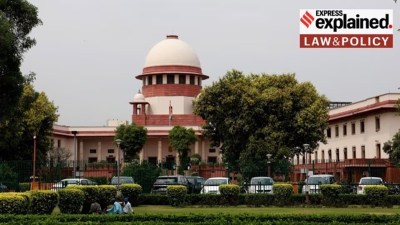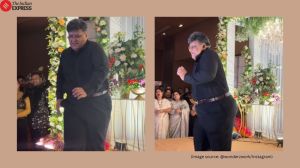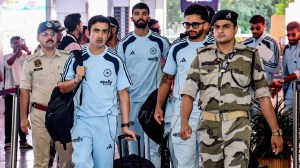As Marathas offered Kunbi tag, move runs into OBC opposition in Maharashtra
The idea of categorising the Marathas as OBC has its origins in the past. In Vidarbha, Konkan and parts of northern Maharashtra, Maratha-Kunbis have already availed reservation under the OBC category for the past several decades.
 Maratha Kranti Morcha members hold a demonstration against Maharashtra government in Mumbai, after clashes between police and protesters demanding Maratha quota in Jalna district. (Express photo by Amit Chakravarty)
Maratha Kranti Morcha members hold a demonstration against Maharashtra government in Mumbai, after clashes between police and protesters demanding Maratha quota in Jalna district. (Express photo by Amit Chakravarty) The Maharashtra government’s move to meet the long-pending demand of reservation by Marathas by providing the same within the OBC quota is set to have a difficult run, with other OBC groups consolidating against them.
The Maratha Kranti Morcha (MKM) that is spearheading the protests has said the Marathas should be given reservation under the OBC category, and that the Centre and state should do this by expanding the overall ceiling beyond 50%.
Marathas are estimated to account for 33% of the state’s population, with the OBCs collectively adding up to 52%. If the issue blows up, it will have larger ramifications for the state’s politics, especially in the 2024 Lok Sabha and Assembly elections.
The president of the OBC Jan Morcha, Prakash Shendge, said they would not allow a Maratha quota within the OBC category. The working president of the Morcha, Chandrakant Bavkar, warned of state-wide agitation to stop it.
The Congress, NCP (Sharad Pawar) and Shiv Sena (UBT) have taken up the spreading Maratha quota agitation to target the BJP-led NDA government, accusing it of failing to resolve the issue. With Sharad Pawar, the state’s tallest Maratha leader, at the helm, the Opposition hopes to use the agitation to its advantage.
The government hopes that the decision taken Wednesday to provide Kunbi caste certificates to all Marathas from Marathwada who possess Nizam-era documents that recognised them as Kunbis, will at least lower the heat for some time. The protests are a setback for Maharashtra’s ruling coalition, given that Shinde and Ajit Pawar are themselves from the Maratha community.
The BJP has also been trying an OBC consolidation by reviving its old formula MADHAV, a combination of Mali, Dhangar and Vanjari (all OBCs). Aggressive campaigns and outreach plans across the state are underway under its OBC state party president Chandrashekhar Bawankule.
Maratha, Kunbi as OBC
The idea of categorising the Marathas as OBC has its origins in the past. In Vidarbha, Konkan and parts of northern Maharashtra, the Maratha-Kunbis have already availed reservation under the OBC category for the past several decades.
The MKM frequently talks about Kunbis in Vidarbha and Khandesh (northern Maharashtra) regions of Maharashtra availing quota benefits, even as the Marathas living in Marathwada (western Maharashtra) are denied the same.
The credit for availing reservation for Kunbi Marathas goes to Panjabrao Deshmukh, a Union agriculture minister in the Jawaharlal Nehru Cabinet, who led the demand back in the 1960s. He played a major role in creating awareness among the Kunbi Marathas to fight for quota, which was accorded several decades later, after the Mandal Commission Report in 1992. In Maharashtra, the Congress government in 2004 officially accepted Kunbis under OBCs.
Himself a Kunbi Maratha, Deshmukh hailed from the backward Vidarbha region and had worked to bring the community, earlier dependent on agriculture, into the mainstream.
The 1953 Backward Class Commission had identified Kunbi and Maratha as one and the same. But at the time, the politically dominant and economically prosperous Marathas of western Maharashtra and Marathwada, did not heed Deshmukh’s decision of reservation.
Gradually, those covered under the quota began to use the name Kunbi alone as their caste marker, dropping the name Maratha.
The Kunbi Sena, led by Vishwanath Patil, opposes the inclusion of Marathas as Kunbis under the OBC category.
SC strikes down SEBC categorisation
In 2018, the then chief minister Devendra Fadnavis had taken into consideration all these conflicts while offering the Marathas reservation as a Socially and Educationally Backward Class (SEBC), based on the recommendations of the State Backward Class Commission led by M G Gaikwad. Under SEBC, the community got 12% and 13% reservation in government education and jobs, respectively. But the Supreme Court struck down both the Maratha reservation and the SEBC Act.
Vanchit Bahujan Aghadi (VBA) president Prakash Ambedkar says, “The Supreme Court did not say Marathas can’t get reservation. It only asked the government to establish the social backwardness of the Marathas, based on which reservations can be given. It also asked how the state government will address the mandatory 50% ceiling on reservations.”
The Maratha demand for reservation cites the community’s educational and economic backwardness. The M G Gaikwad Commission report which led the state to enact the Socially and Educationally Backward Class Act to give reservation to the Marathas, was based on educational and economic backwardness within the community.
The Gaikwad Commission report had said, “93% families had an annual income of Rs 1 lakh. 37.38% families were Below Poverty Line, against the state average of 24.2%. Importantly, 71% owned less than 2.5 acre land.”
A couple of days ago, NCP president Sharad Pawar suggested that Marathas should get 16% reservation, for which, the Centre and the state government should work towards increasing the reservation limit. Similar sentiments have been voiced by others.
Sources in the state legal department, requesting anonymity, said, “Even if the state government gave 16% quota to Marathas, it would be challenged in court, as the question of the category under which they would be offered reservation, would remain.” Already, the SC has rejected the SEBC Act.
That leaves OBC as the only option under which Marathas can be accommodated under the reserved categories, he observed.
OBC leader Haribhau Rathod, who has taken a neutral stand on the issue, said, “Maratha and Kunbis should be clubbed and given a flat 5% quota as an OBC sub-category. It will resolve the problem.” He also said, “The total reservation for OBCs in Maharashtra is 19%. It covers over 380 communities, including Kunbi Marathas. Now, the Most Backward among OBC are deprived, as Kunbis corner most of the reservation benefits.” He added, “If instead, Marathas and Kunbis together are allocated 5%, others will benefit.”
Maharashtra’s quota jumble
The state presently has 52% quota. The composition is as follows: SC 13%; ST 8 %; OBC 19%; State Backward Caste 2%; Vimukti Jati 2%; Nomadic Tribe 2.5%; Nomadic Tribe (C) (Dhangar) 3.5%; Nomadic Tribe (D) Vanjari 2%.
Apart from these, there is 10% reservation for the Economically Weaker Sections (EWS), which is applicable to households with annual income less than Rs 8 lakh. It is applicable to all non quota communities, irrespective of caste, community and religion.
Combined with the EWS, the total quota goes upto 62%.
Beyond the socio-economic impact, reservation politics has a larger political bearing. Opposition leader Vijay Waddetiwar of the Congress has already said, “We will not allow dilution of the OBC reservations. Maratha reservation should not be at the cost of OBCs.”
Senior Cabinet minister Chhagan Bhujbal of the NCP (Ajit Pawar) expressed similar concerns. He said, “There is no question of compromising the existing OBC quota. The reservation given to SC/ST/OBCs should remain intact. We are not against Maratha quota. But it should be without affecting OBCs.”
Squaring up, the Maratha Mahasangh responded in kind, stating, “If anybody scuttles our reservation rights, they will face serious consequences.”
Rallying under activist Manoj Jarasange Patil, who is on indefinite fast at Antarwali Sarathi in Jalna district from August 29, the MKM has started demanding their rights under the OBC category, as they reckon reservation is meaningless without legal and constitutional validity. MKM leader Rajendra Kondare said, “Maratha and Kunbis are the same, and reservation as OBC is the way to address the problem.”


- 01
- 02
- 03
- 04
- 05





























